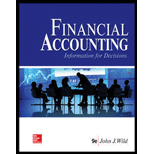
Introduction: Liability is the debt or legal obligation that a company raises due to business operation. Liabilities are of two kinds current and noncurrent.
To determine: The total amount of liability A has reported on September 24, 2016 and September 26, 2015
2.
Introduction: Asset of the company is the source of income for the company which can be controlled by the board of directors. It helps to generate income for various purposes like for dividend and interest distribution to shareholders and debenture holders.
To determine: The total amount of assets A has reported on September 24, 2016 and September 26, 2015.
3.
Introduction: Equity refers to the stock which depicts ownership of the investor in the company. It is calculated by reducing the liability value from assets. The debt equity ratio is the ratio of debt and equity in the capital structure of the company
To compute: The debt equity ratio of A on September 24, 2016 and September 26, 2015.
Introduction: Debt equity ratio is the ratio of debt and equity in the capital structure of the company. Financial leverage is determined by the ratio of debt and equity in the capital structure of the company
To determine: The fiscal year which employee more financial leverage.
Want to see the full answer?
Check out a sample textbook solution
Chapter 2 Solutions
Loose Leaf for Financial Accounting: Information for Decisions
 Financial AccountingAccountingISBN:9781305088436Author:Carl Warren, Jim Reeve, Jonathan DuchacPublisher:Cengage Learning
Financial AccountingAccountingISBN:9781305088436Author:Carl Warren, Jim Reeve, Jonathan DuchacPublisher:Cengage Learning Intermediate Accounting: Reporting And AnalysisAccountingISBN:9781337788281Author:James M. Wahlen, Jefferson P. Jones, Donald PagachPublisher:Cengage Learning
Intermediate Accounting: Reporting And AnalysisAccountingISBN:9781337788281Author:James M. Wahlen, Jefferson P. Jones, Donald PagachPublisher:Cengage Learning Managerial AccountingAccountingISBN:9781337912020Author:Carl Warren, Ph.d. Cma William B. TaylerPublisher:South-Western College Pub
Managerial AccountingAccountingISBN:9781337912020Author:Carl Warren, Ph.d. Cma William B. TaylerPublisher:South-Western College Pub Financial And Managerial AccountingAccountingISBN:9781337902663Author:WARREN, Carl S.Publisher:Cengage Learning,
Financial And Managerial AccountingAccountingISBN:9781337902663Author:WARREN, Carl S.Publisher:Cengage Learning,



